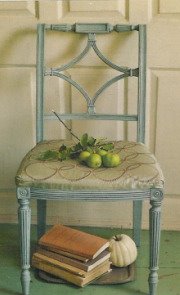
Have you been watching the new series "Life" on Discovery Channel? If you were fascinated by the images and wonders of "Planet Earth", you'll want to check out "Life". Last night, I watched the "Birds" episode and my shelter- and decor-obsessed eye was naturally drawn to the bowerbirds of New Guinea. It is seriously amazing what the males of some species will do to get a girl.

As part of their courtship and mating ritual, the male birds build a bower, a structure made of sticks and twigs. The New Guinea variety of bowerbird builds the most impressive display, a maypole bower, which consists of a center support and a wide, domed roof. The photo below will help you visualize just how large such bowers can be. The bird you see to the left of the center support is typically eight or so inches tall. Another variety of the species, the bowerbird of Northern Australia, builds an avenue bower, two walls of vertically placed sticks that resemble the classic laurel leaf crest.


Once construction is complete, the decorating process begins. Most often, the floor of the maypole bower is cleared of all unwanted debris. A carpet of green moss may be laid. Piles of colorful objects, the brighter and shinier the better, are collected and artfully arranged in and around the bower. Different species of bowerbirds are known to collect materials unique to them, or perhaps to their surroundings, which may include shells, leaves, flowers, feathers, stones and berries. Discarded plastic items, coins, nails, even bits of glass—things left behind by human inhabitants within the birds' range—are often used as well. Hours will be spent arranging and rearranging the items, often numbering in the hundreds, in a way the bird believes will best present him as an ideal mate.

Several males will build bowers in close proximity to one another, which makes it much more convenient for the female bird to choose between them. She visits often during the building process. She will closely examine the collected objects and quality of construction once each bower is complete. In the end, she may select the same male she chose last year if he continues to impress. Under-performing males are left without mates and nothing but time—time a smart bird would put to good use improving his bower-building skills. Interestingly, once the bower has played its part in the mating ritual, it is abandoned. Nesting takes place in more humble surroundings, built by the female herself, of soft materials, such as leaves, ferns, and vine tendrils on top of a loose foundation of sticks.

Patrick Dougherty is an artist from North Carolina who, like the bowerbird, builds elaborate, fanciful structures from twigs and sticks. While it does not appear as though Mr Dougherty does this to attract a mate, his art certainly attracts attention. His works intrigue viewers, drawing them in for closer inspection, like a female bowerbird to the most beautiful bowers. With birds (and beavers) as his guides, Dougherty sometimes takes up to a full year to construct his installations in pastoral settings, among buildings and trees, and within the walls of museums worldwide. Of his work, the artist says "Art that's made out of natural materials goes out into the civilized world while coexisting with the natural world, so it offers a new way of looking at both". Images below are from stickwork, his aptly named website. The ephemeral nature of these stick structures, whether built by bowerbirds or artists like Patrick Dougherty, make it important to fully appreciate them once encountered as it's unlikely they'll still be there on your next visit.
If you have experienced such art in person, whether built by bird or man, I'd love to hear about it.

Trailheads. North Carolina Museum of Art, Raleigh, North Carolina. 2005

Call of the Wild. Museum of Glass, Tacoma, WA. 2002

Na Hale 'o waiawi. The Contemporary Art Museum, Honolulu, HI. 2003

Sortie de Cave. Jardin des Arts, France. 2008

The Summer Palace. Morris Arboretum of The University of Pennsylvania, Philadelphia, PA. 2009





































































































10 comments:
You should check out Andy Goldsworthy:
http://images.google.com/images?q=andy%20goldsworthy&rls=com.microsoft:en-us&oe=UTF-8&startIndex=&startPage=1&um=1&ie=UTF-8&sa=N&hl=en&tab=wi
He's one of my all-time favorite artists!
Thanks for the link Kasey!
I took a quick look and am pretty amazed. I'll go back to see more. I'm so interested now to find out where such artists as Dougherty and Goldsworthy might be exhibiting or if there area any permanent installations near me. Isn't it wonderful where random channel and web surfing can take us?!
Oh that was a great post! Thanks for sharing that!! We love "Life" in our home but missed last nights episode. Great blog you have too BTW! -Kristen
What?! That was crazy! Love those giant nest sculptures! The last one especially!
I have not watched that show b/c, well I don't watch tv. But I have seen this artists work in a magazine. It is amazing and so beautiful.
~janet
Animals are just so amazing!!!
We're lucky enough to be members at a children's museum in Sausalito, California (the Bay Area Discovery Museum - badm.org) where Patrick built a fantastical, maze-like house. The children LOVE playing in here - they play house, tag, hide and seek (there are so many nooks and crannies). The most wonderful thing is that the installation was only supposed to last a short time, and it's been up for many years, now. The willow branches Patrick used have rooted themselves in the ground and in the spring and summer there is greenery on the top. I was just there, today, with my four-year old, but didn't get any pictures of the structure. Here's a url link to the photo, which really does not do justice to the magnificent, magical nature of this piece of art. Just for scale, an adult can walk through the doorway openings without having to stoop much.
http://www.baykidsmuseum.org/index.php?eID=tx_cms_showpic&file=uploads%2Fpics%2FLOC-willow.jpg&width=800&height=600m&bodyTag=%3Cbody%20style%3D%22margin%3A0%3B%20background%3A%23fff%3B%22%3E&wrap=%3Ca%20href%3D%22javascript%3Aclose%28%29%3B%22%3E%20%7C%20%3C%2Fa%3E&md5=fe8b93f0a36773bd17b49999c6e986bc
Sorry the link is so long! Hope you get a chance to enjoy this wonderful museum. - Mae
Thanks Mae! What a wonderful, imagination-sparking structure. And how lucky that it's rooted and seems to want to stay.
I had a hard time with your link though, so here's a less direct link for any readers who happen upon these comments and want to see what Mae saw:
http://www.baykidsmuseum.org/tour-the-museum/lookout-cove/lookout-cove-artists/
On the page it takes you to, click on the "Willow Sculpture" pic.
Designer birds! Who knew? Those Patrick Dougherty structures are pretty imaginative too.
UN!!! Believeable, Love this post!!
Post a Comment